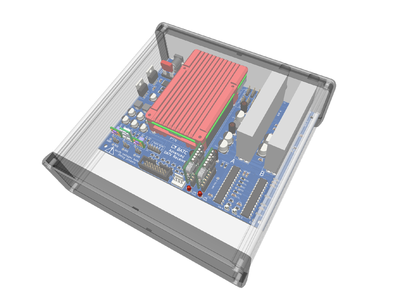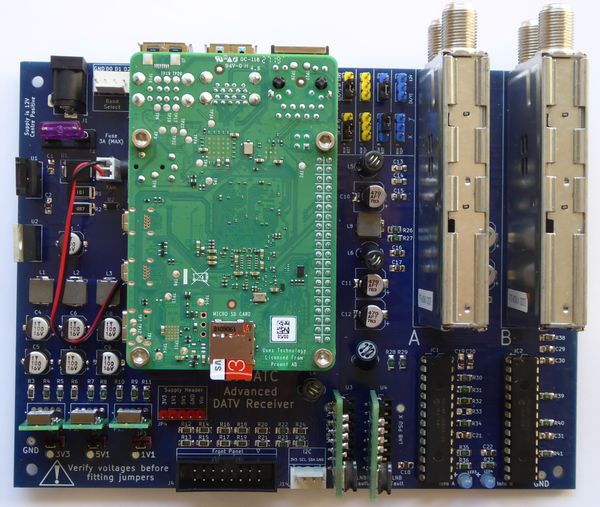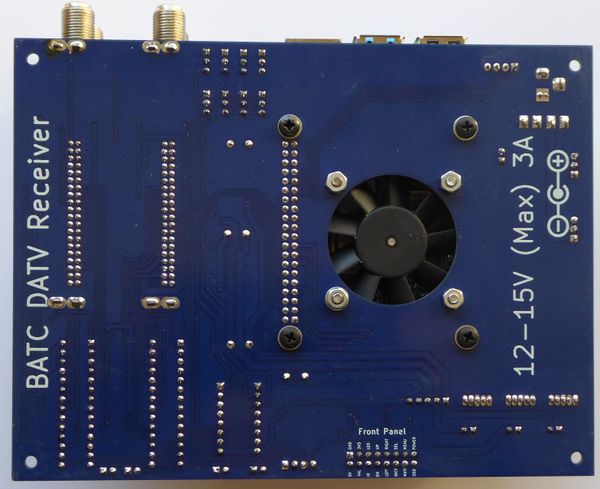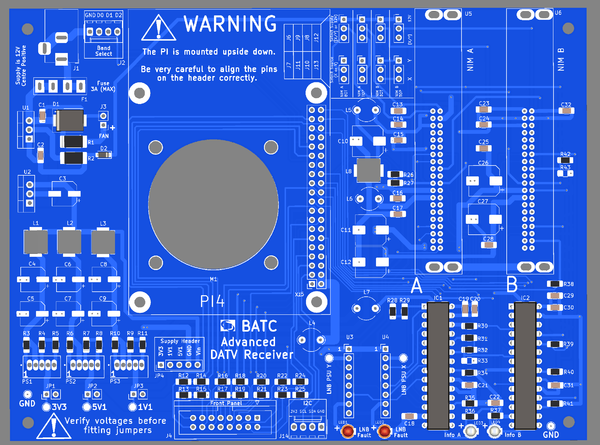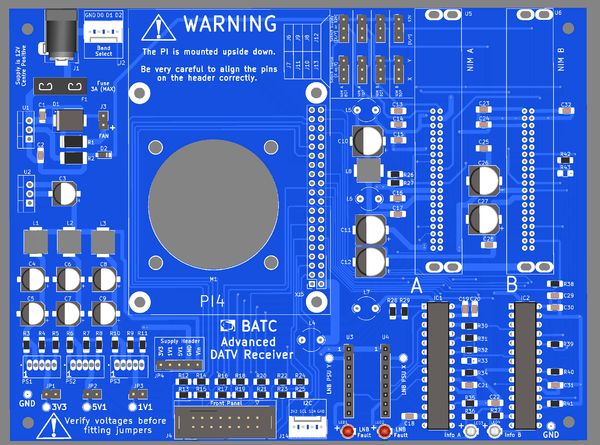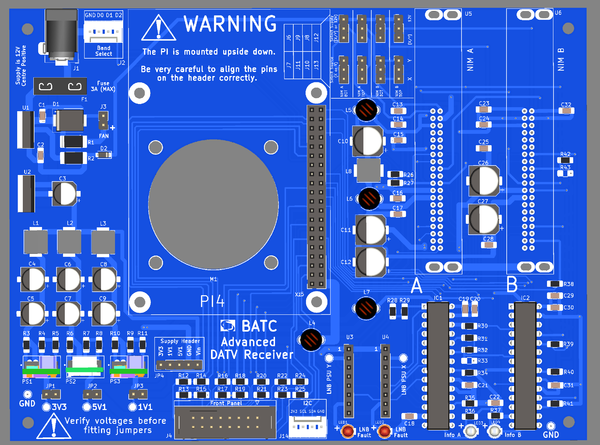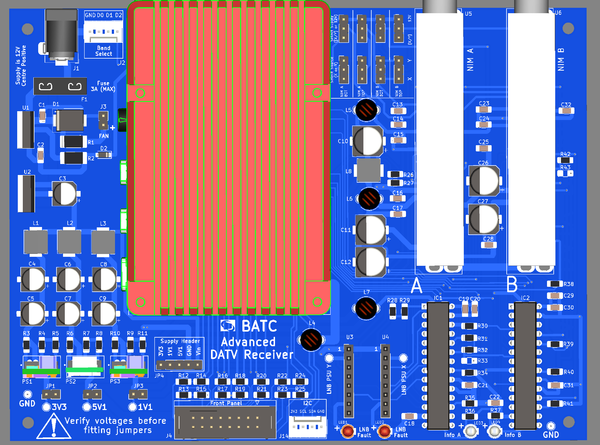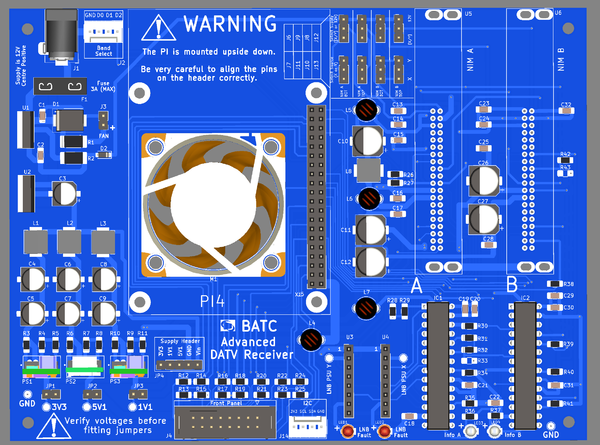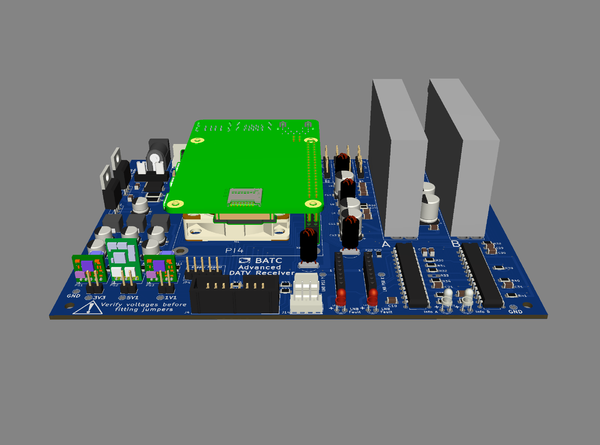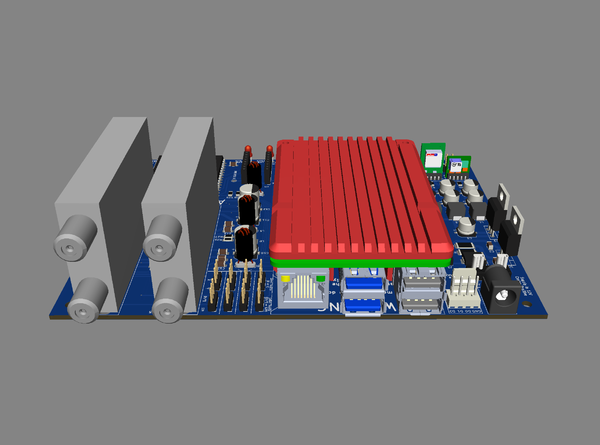Difference between revisions of "Advanced receiver hardware"
(→Step 6) |
|||
| (6 intermediate revisions by 3 users not shown) | |||
| Line 2: | Line 2: | ||
The BATC advanced receiver hardware is a PCB designed to host up to 2 Serit FTS4334L or FTS4335 NIMs, which can receive DVB-S or DVB-S2, and a Raspberry Pi4. | The BATC advanced receiver hardware is a PCB designed to host up to 2 Serit FTS4334L or FTS4335 NIMs, which can receive DVB-S or DVB-S2, and a Raspberry Pi4. | ||
| − | [[File:Boxed.png| | + | [[File:Boxed.png|400px|center|Boxed]] |
==Applications== | ==Applications== | ||
| − | The first application to use the advanced receiver hardware will be the [[ | + | The first application to use the advanced receiver hardware will be the [[WinterHill Receiver Project]] which is a multi-channel DVB-S2 receiver running on a RPi desktop. |
| + | ==Schematic and Parts List== | ||
| + | |||
| + | Schematic is here: | ||
| + | '''[[File:Winterhill.pdf|thumb|Schematic]]''' | ||
| + | |||
| + | BOM is here: | ||
| + | '''[[File:Winterhill BOM.xlsx|thumb]]''' | ||
==Hardware Build== | ==Hardware Build== | ||
| Line 15: | Line 22: | ||
[[File:Built Receiver.jpg|600px||Built Hardware]] | [[File:Built Receiver.jpg|600px||Built Hardware]] | ||
[[File:Reverse.jpg|600px|Reverse]] | [[File:Reverse.jpg|600px|Reverse]] | ||
| − | |||
| − | |||
| − | |||
| − | |||
| − | |||
| − | |||
It is best to build this in order of component height. It took the author about 3 hours. There is an old proverb, a man with a watch knows the time. A man with two watches is never sure. While working with SMT, if you make a mistake, having two soldering irons to had is a great help when removing misplaced components. The other essential trick is to have the right tools for the job, a fine tip iron and thin, ideally 0.3mm solder. Ideally, use stainless steel tweezers for placement. With experience you can use bar solder and a poker, but you are on your own there. Plenty of light and magnification is a must. If you don't have a magnifier then some +2 or +3 reading glasses might help those with normal vision. | It is best to build this in order of component height. It took the author about 3 hours. There is an old proverb, a man with a watch knows the time. A man with two watches is never sure. While working with SMT, if you make a mistake, having two soldering irons to had is a great help when removing misplaced components. The other essential trick is to have the right tools for the job, a fine tip iron and thin, ideally 0.3mm solder. Ideally, use stainless steel tweezers for placement. With experience you can use bar solder and a poker, but you are on your own there. Plenty of light and magnification is a must. If you don't have a magnifier then some +2 or +3 reading glasses might help those with normal vision. | ||
| Line 56: | Line 57: | ||
===Step 6=== | ===Step 6=== | ||
| − | Next the regulators and ferrite chokes: | + | Next the regulators and ferrite chokes. You might want to put the board in the case to get the TO220 devices in the right place for bolting to the box. They need to be heatsinked: |
[[File:Stage 6.png|600px|Regulators and Chokes]] | [[File:Stage 6.png|600px|Regulators and Chokes]] | ||
| Line 92: | Line 93: | ||
The board is now ready for testing. First fit the PI4 and jumpers JP1, JP2 and JP3. If you test it outside the case use no more than 12V, otherwise U2 will get hot. It needs to be heatsunk to the case. So does U1 if you plan to use it. The current should be under 1A. | The board is now ready for testing. First fit the PI4 and jumpers JP1, JP2 and JP3. If you test it outside the case use no more than 12V, otherwise U2 will get hot. It needs to be heatsunk to the case. So does U1 if you plan to use it. The current should be under 1A. | ||
| − | If all OK, go to the software installation section. The PI OS needs to be loaded and the PICs need to be programmed. | + | If all OK, go to the software installation section. The PI OS needs to be loaded and the PICs need to be programmed, which is done automatically by the software installation process. |
| + | |||
| + | See here for WinterHill documentation and software downloads: '''[[WinterHill Receiver Project]]''' | ||
Latest revision as of 20:09, 27 March 2021
The BATC advanced receiver hardware is a PCB designed to host up to 2 Serit FTS4334L or FTS4335 NIMs, which can receive DVB-S or DVB-S2, and a Raspberry Pi4.
Applications
The first application to use the advanced receiver hardware will be the WinterHill Receiver Project which is a multi-channel DVB-S2 receiver running on a RPi desktop.
Schematic and Parts List
Schematic is here: File:Winterhill.pdf
BOM is here: File:Winterhill BOM.xlsx
Hardware Build
The hardware uses a mixture of surface mount and through hole components. These are very large surface mount parts by modern standards. If you have not used surface mount before, do try it. After a while most people find it easier than through hole as there is no need to keep turning the board over.
It is best to build this in order of component height. It took the author about 3 hours. There is an old proverb, a man with a watch knows the time. A man with two watches is never sure. While working with SMT, if you make a mistake, having two soldering irons to had is a great help when removing misplaced components. The other essential trick is to have the right tools for the job, a fine tip iron and thin, ideally 0.3mm solder. Ideally, use stainless steel tweezers for placement. With experience you can use bar solder and a poker, but you are on your own there. Plenty of light and magnification is a must. If you don't have a magnifier then some +2 or +3 reading glasses might help those with normal vision.
Step 1
Starting with an unpopulated PCB fit all the parts shown, Resistors, Ceramic capacitors, Diodes, Inductors:
Step 2
Next fit the 2 PICs and 4 LEDs - ideally use IC sockets for the PICs.
Step 3
Next fit the Electrolytic capacitors
Step 4
Now fit the pin headers and fuse holder:
Step 5
Then the DC jack and remaining headers EXCEPT to PI GPIO header.
Step 6
Next the regulators and ferrite chokes. You might want to put the board in the case to get the TO220 devices in the right place for bolting to the box. They need to be heatsinked:
Step 7
Now for the PI GPIO header. This requires thought and care. It needs to be at the correct height above the PCB and that depends on how you plan to mount the PI and if it has a heatsink case or not. Test fit the header to the PI and mount the PI on the PCB, then the header will be in the correct place. Removing the header afterwards is almost impossible without damaging the PCB so take time to get this right. Best now remove the PI to prevent damage, or treat it with care if you choose not to. If it is in the metal case it will probably be fine. If mounting the PI PCB on stand-offs 20mm ones are a good choice, providing clearance for a 40x40x10mm fan. The fan blowing air on the PI appears to provide adequate cooling. Remember to put vents in the case, ideally underneath the fan as circulating hot air inside a sealed box will keep the temperatures even, but it won't do much to actually cool it all down. It is also worth putting exhaust holes near the NIMs as these also tend to get warm. Total dissipation is around 10 Watts.
Fit the fan if required.
Step 8
Once that's done it is time to power up and test the voltages are correct. It won't work if you don't fit the fuse. Ideally use a current limited 12V supply and pay attention to the current, - there should not be any. Make sure the JP1,2,3 jumpers are open. Check for correct voltages and fix if not.
Step 9
If all is well fit the NIM(s). Make sure they are properly seated. Do not use a socket if you want the board to fit in the recommended case, there is insufficient clearance and it won't fit.
The heatsinking solution is up to you. If it is just the PCB with a fan beneath it then 20mm spacers or longer are appropriate. With a heatsink case you need to get more creative.
The two TO220 regulators on the edge of the PCB require heatsinking. If you are using the suggested case they can be bolted to the side. If you plan to use a different case remember, to account for this. Note also that the LM317 MUST be in the plastic package. If you can't find a plasic packaged one then it will need an insulation kit. The tab is connected to the output. The 12V regulator tab is grounded, so it can be bolted directly to the case.
Testing
The board is now ready for testing. First fit the PI4 and jumpers JP1, JP2 and JP3. If you test it outside the case use no more than 12V, otherwise U2 will get hot. It needs to be heatsunk to the case. So does U1 if you plan to use it. The current should be under 1A.
If all OK, go to the software installation section. The PI OS needs to be loaded and the PICs need to be programmed, which is done automatically by the software installation process.
See here for WinterHill documentation and software downloads: WinterHill Receiver Project
